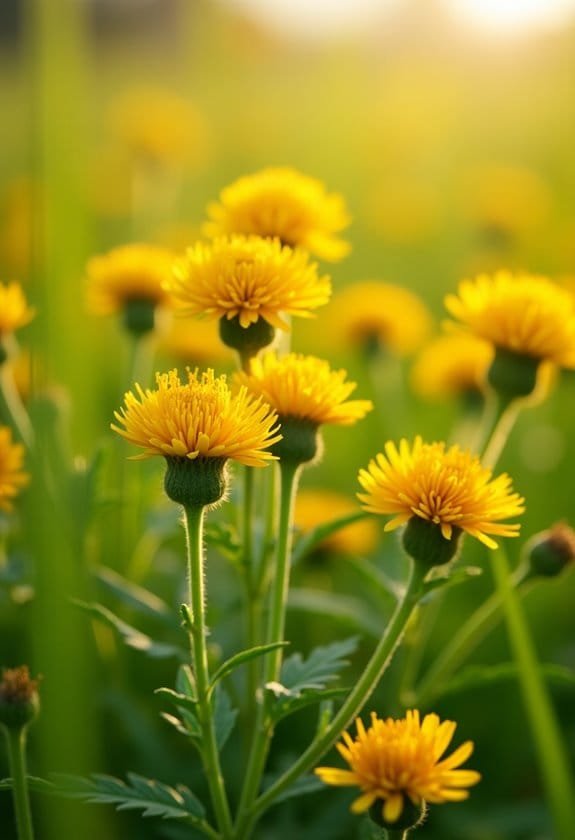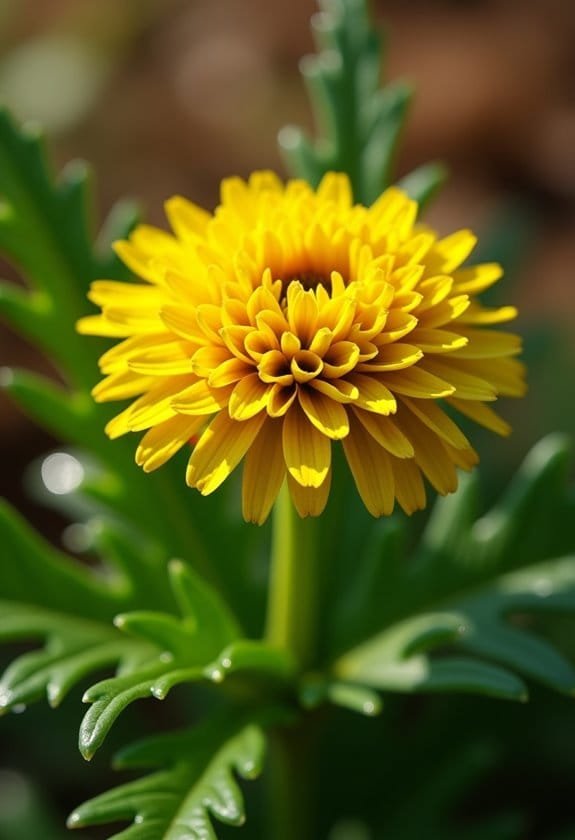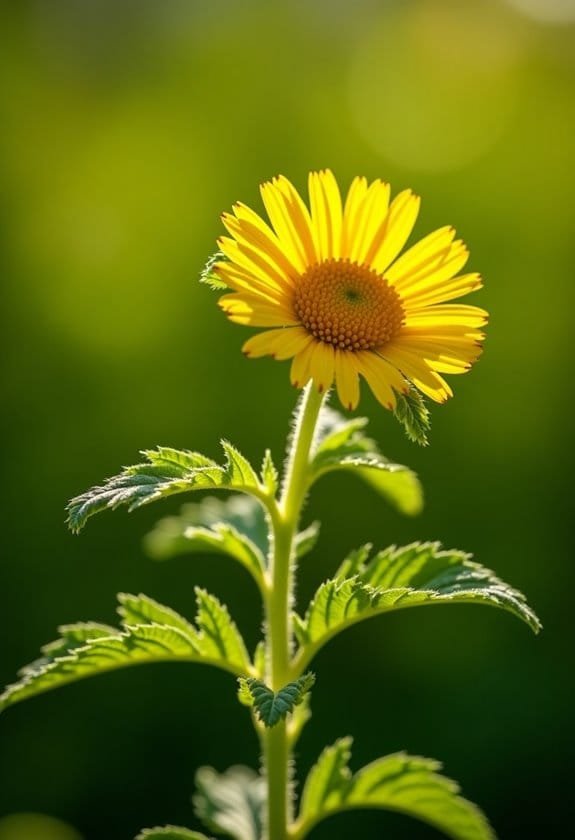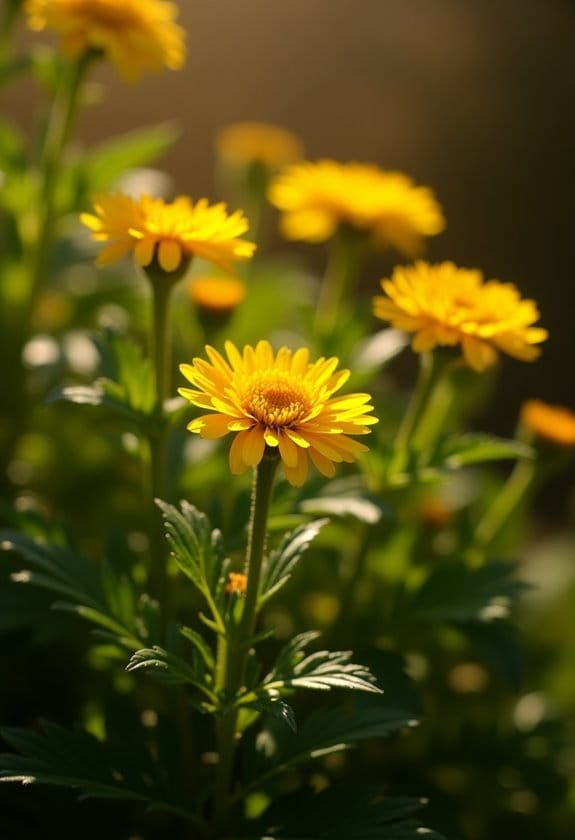Tanacetum vulgare, or Tansy, is a resilient herbaceous perennial native to Europe and Asia, distinguished by its clusters of vibrant golden yellow flowers. This plant typically reaches heights of 1 to 5 feet and flourishes in USDA hardiness zones 3 to 8, thriving in well-drained, compost-rich soil under full sun or partial shade. Tansy plays a significant ecological role, attracting beneficial pollinators like bees, while its aromatic leaves repel pests. However, it contains thujone, a toxic compound, and can become invasive if not managed properly. Understanding its complex nature leads to effective cultivation and utilization strategies. There's much more to explore about this intriguing species.
Main Points
- Tansy (Tanacetum vulgare) is a perennial herb native to Europe and Asia, thriving in USDA hardiness zones 3 to 8.
- It blooms from July to September, displaying clusters of vibrant golden yellow flowers that attract beneficial pollinators.
- Tansy prefers moist, well-drained soils enriched with compost and requires full sun for optimal growth.
- The plant contains thujone, a toxic compound, making it potentially harmful if ingested by humans or livestock.
- Due to its invasive nature, Tansy can disrupt local ecosystems, necessitating careful management and control measures.
Introduction

Common Tansy, scientifically known as Tanacetum vulgare, stands as a remarkable herbaceous perennial renowned for its striking yellow flowers and aromatic foliage.
Native to Europe and Asia, this plant hasn't only adapted well to North American soils since its introduction in the 1600s but has also established itself as a formidable invasive species. Its aggressive growth pattern and ability to produce up to 50,000 seeds in one season highlight its potential to disrupt local ecosystems.
Understanding its characteristics, including its rapid growth and potential toxicity, offers valuable insights into both its historical uses and its implications for modern gardening practices.
Common Name
Known for its vibrant yellow flowers and unique fragrance, Tansy, scientifically referred to as Tanacetum vulgare, has captivated attention since ancient times. The term "Tansy" derives from the Greek word "athanasia," which means "immortal," hinting at the plant's historical significance in traditional medicine.
Its iconic yellow, button-like flowers grace gardens and wild landscapes from July to September, creating a striking visual impact.
In addition to its aesthetic appeal, Tansy possesses notable characteristics, such as its fern-like foliage and erect stems, which help identify the species. When the leaves are crushed, they emit a potent camphor-like odor, which many find distinctive yet strong. This aroma has historically led to Tansy's use as an insect repellent and its valued role in culinary practices during medieval Europe.
However, Tansy's aggressive growth pattern can make it an invasive species, often recognized as a noxious weed in numerous states throughout the U.S.
Those who cultivate this intriguing plant should remain vigilant, balancing its ornamental benefits with the environmental impact of its rapid proliferation. Tansy, with its engaging history, continues to be a fascinating subject of interest for botanists and gardeners alike.
Scientific Name
Tansy, scientifically classified as Tanacetum vulgare, belongs to the Asteraceae family and has a storied presence in various ecosystems. This perennial herbaceous plant, native to Europe and Asia, underscores its adaptability, having been introduced to North America in the 1600s.
Its striking features include fern-like foliage and a profusion of golden yellow, button-like flowers, which bloom from July to September, enchanting biodiversity around it.
When crushed, the leaves emit a pungent odor, largely due to thujone, a toxic compound that can be harmful in high concentrations. This distinctive characteristic serves as a protective measure, deterring herbivores while exhibiting its chemical prowess.
Tanacetum vulgare possesses an impressive capacity for reproduction, as it can spread rapidly through its rhizomatous roots and an astonishing production of up to 50,000 seeds annually. Consequently, its prolific nature has led to its classification as a noxious weed in numerous regions, highlighting the challenges associated with its cultivation.
Understanding the scientific name and distinct characteristics of Tansy enables better management and appreciation of its role within various ecosystems.
Overview
The versatile perennial herb, Tanacetum vulgare, also referred to as common tansy, plays a significant role in many ecosystems. This herbaceous plant, which can grow between 1 to 5 feet tall, showcases striking golden yellow button-like flowers that bloom from July to September.
With its fern-like, aromatic leaves reaching up to 12 inches, common tansy releases a pungent scent when crushed, a characteristic that identifies the species. Nectar-rich blooms of common tansy also attract various pollinators, enhancing local biodiversity.
Native to Europe and Asia, this member of the Asteraceae family was introduced to North America in the 1600s, where it subsequently became an invasive species in various regions.
Common tansy reproduces quickly, both through rhizomes and the astonishing capacity to produce up to 50,000 seeds annually, leading to dense vegetation that can overshadow native flora.
Historically, common tansy has been utilized for medicinal purposes, treating ailments such as rheumatism. However, caution is vital due to its toxicity; it contains thujone, a compound capable of inducing severe health risks in humans and livestock.
Therefore, while the plant holds ecological importance, its use warrants careful consideration and respect for its potential dangers. Additionally, invasive species like common tansy can significantly impact local ecosystems by outcompeting native vegetation, similar to the effects seen with Great Willowherb.
Key Features
Common Tansy (Tanacetum vulgare) showcases impressive growth, reaching heights between 1 to 5 feet and adorned with fern-like leaves that, when crushed, release a strong camphor-like aroma.
From July to September, it captivates with its distinctive golden yellow, button-like flowers arranged in corymb-shaped clusters, often containing 20 to 200 individual heads.
This resilient plant not only flourishes in moist humus soils but also boasts high reproduction rates, capable of producing up to 50,000 seeds each year, ensuring its persistent presence in diverse environments.
Growth Size
Growing vigorously, common tansy (Tanacetum vulgare) typically reaches heights between 1 and 5 feet, characterized by its upright, erect stems. This perennial showcases a remarkable growth habit, making it an attractive addition to flower beds and gardens. Its deeply divided, fern-like leaves—ranging from 2 to 6 inches wide and extending up to 12 inches long—contribute to its lush appearance.
Tansy's growth size is further influenced by its rapid spreading nature, fueled by a rhizomatous root system and astounding seed production. A single plant can produce as many as 50,000 seeds annually, highlighting its potential for expansion in various environments.
While it favors moist humus soils, common tansy is also remarkably drought-resistant, successfully adapting to disturbed areas with less-than-ideal conditions.
From July to September, clusters of golden yellow flowers, resembling tiny buttons, bloom—measuring between 1/4 and 1/2 inch wide—and add a splash of color to the landscape.
Understanding the growth size of common tansy is essential for gardeners looking to cultivate this resilient native plant effectively, ensuring it thrives within their chosen environments.
Appearance
Featuring a striking appearance, tansy (Tanacetum vulgare) typically showcases erect, branching stems that range in color from brown to reddish-brown.
This robust herbaceous plant often grows between 1 to 5 feet tall, projecting a sense of stature and liveliness in its environment. The leaves are distinctly fern-like, deeply divided, and can measure up to 12 inches long. When crushed, they emit a pungent, camphor-like odor, adding an intriguing olfactory element to their visual presence.
Tansy's most notable feature is its clusters of vibrant golden yellow flowers, reminiscent of tiny buttons. These blooms, which appear from July to September, are arranged in dense, corymb-like formations, containing anywhere from 20 to 200 heads.
Ranging from 1/4 to 1/2 inch wide, they resemble petalless daisies, creating a unique allure that attracts attention. After flowering, the plant produces small, dark brown achenes as fruits, which contribute to its prolific reproductive capabilities.
Flowering Season
From July to September, Tansy (Tanacetum vulgare) bursts into bloom, showcasing its vivid golden yellow flowers that resemble tiny buttons.
During this flowering season, clusters of flowers, referred to as corymbs, contain anywhere from 20 to 200 individual heads, forming a dense, eye-catching display. Each flower measures between 1/4 to 1/2 inch wide, giving Tansy a recognizable daisy-like appearance.
This striking show of bright yellow flowers serves an important function in attracting beneficial insects, such as bees and butterflies, thereby enhancing the garden's biodiversity during the summer months. The blooms not only contribute aesthetic value but also play a critical role in pollination, which is essential for many plants' reproductive success.
As the flowering season concludes, Tansy shifts to fruit production, developing small, dark brown achenes that mature from late summer to fall.
These achenes guarantee the plant's continued reproduction, thereby perpetuating its presence in the ecosystem. This seamless cycle—from vibrant blooms to fruitful seeds—demonstrates Tansy's ecological significance, firmly rooting it within the fabric of its habitat and underscoring the interconnectedness of nature's many elements.
Growing Requirements

Tansy's growing requirements reflect its adaptability to various environments, thriving in full sun to partial shade while encompassing USDA hardiness Zones 3 to 8.
To truly flourish, these plants prefer well-drained soil enriched with compost, which enhances nutrient availability and supports overall growth.
With proper spacing of 12 to 18 inches between plants, gardeners can guarantee adequate air circulation, thereby preventing overcrowding and potential disease outbreaks. Additionally, Tansy is resilient to temperature fluctuations, enabling it to adapt to a variety of climatic conditions.
Light
Thriving in full sun, Tansy (Tanacetum vulgare) is well-suited for a variety of light conditions, although it can tolerate partial shade. While Tansy prefers full sun, achieving ideal growth requires at least six hours of direct sunlight daily. This exposure not only fosters robust development but also contributes to its distinctive, upright stature.
Insufficient light can lead to leggy growth patterns, greatly reducing both flower production and the plant's ornamental value. Young Tansy plants greatly benefit from full sun, as it encourages the formation of strong stems and lush foliage; without adequate light, their growth may falter, and the characteristic foliage can become sparse.
Furthermore, while established Tansy displays remarkable drought tolerance, its overall vigor and performance improve considerably under consistent sunlight paired with moderate watering. Consequently, for gardeners aiming to cultivate a flourishing patch of Tansy, understanding these light requirements is essential.
Soil
The ideal soil for growing Tansy (Tanacetum vulgare) is well-drained and rich in humus, as these conditions help the plant retain moisture while still allowing for good drainage. This perennial thrives best when granted a soil pH between 6.0 and 7.0, facilitating ideal nutrient absorption and growth.
By maintaining these pH levels, gardeners can effectively manage Tansy's rapid growth, preventing undesirable overcrowding in their gardens.
Incorporating compost into the soil during planting or at the start of the growing season further enhances Tansy's importance. This organic matter enriches the soil, providing essential nutrients and improving moisture retention.
Though Tansy is relatively drought-tolerant once established, ensuring regular soil moisture in the first year after planting is essential. A well-developed root system in these initial stages lays the groundwork for the plant's longevity and resilience.
Gardeners must keep a vigilant eye on soil conditions, particularly during dry spells. Meeting Tansy's need for moisture not only supports overall health but also promotes a sturdy structure, ensuring that this vibrant herb fulfills its role in any garden landscape. Additionally, Tansy can benefit from well-drained soil similar to that preferred by Comfrey, which helps prevent root rot.
Water
While Tansy can tolerate drought once it's established, it still needs consistent moisture during its early growth stages for ideal development. Optimal water management is vital in encouraging Tansy (Tanacetum vulgare) to thrive. This resilient plant prefers moist, well-drained soils, contributing to its health.
During its initial growth phase, regular moderate watering, roughly 1 inch per week, is recommended; this practice supports robust root system establishment and overall plant vigor.
As the plant matures, Tansy becomes more drought-resistant, requiring less frequent water. However, during prolonged dry spells or periods of extreme heat, deep watering becomes more significant. It helps guarantee that roots extend into the moist soil, fostering resilience against adverse conditions.
Gardeners must exercise caution to avoid over-watering, which can introduce root rot—an affliction caused by excess moisture hindering proper aeration. As a result, maintaining adequate drainage within the planting area mitigates this risk.
Additionally, planting Tansy in sunny locations, whether full sun or partial shade, further enhances its moisture retention abilities, allowing for sustained growth. This synergy of light and water ultimately prepares Tansy for a fruitful existence, delivering vibrant blooms and strong presence in any garden.
Temperature
Establishing Tansy (Tanacetum vulgare) requires attention to water management, but temperature also plays an important role in its growth. This hardy perennial flourishes in USDA hardiness zones 3 to 8, meaning it can endure a diverse range of temperatures, from frigid winters to warm summers. Full sun exposure is preferred, yet Tansy can tolerate partial shade, vital for facilitating ideal growth and flourishing blossoms.
While Tansy showcases impressive resilience to varying temperature conditions, extreme heat during summer months necessitates additional moisture to avert stress. This moisture not only sustains the plant but also aids in its vigorous growth cycle, which thrives in well-drained, moist humus-rich soils. Moreover, Tansy contributes to enhancing biodiversity in garden ecosystems by attracting various pollinators.
Despite its drought-resistant nature once established, Tansy benefits greatly from moderate watering during extended dry spells. By ensuring adequate moisture levels, gardeners can support lush foliage and prolific flower production.
Ultimately, warm temperatures combined with appropriate moisture create an environment where Tansy can thrive, highlighting the delicate balance that supports plant health. Understanding and managing these conditions allows gardeners to cultivate vibrant Tansy, enriching their gardens with its charming blooms.
Pollinator Criteria
Tansy's vibrant yellow flowers not only allure the human eye but also attract a diverse array of pollinators, particularly bees and butterflies.
These insects, drawn to the plant's rich nectar, play an essential role in its pollination process, facilitating the reproduction of the species and ensuring the continuation of the ecosystem.
Attracted Pollinators
The bright yellow flowers of Common Tansy (Tanacetum vulgare) serve as a magnet for various pollinators, including bees and butterflies. Blooming from July to September, these button-like flowers contain nectar-rich clusters that provide essential sustenance for many native bee species during their active periods.
The aromatic leaves and dense foliage of the plant create an inviting habitat, enhancing biodiversity within gardens and promoting ecological balance.
Studies indicate that effective management of Common Tansy markedly boosts pollinator visitation rates, enriching neighboring crops through enhanced pollination. This critical relationship underscores the plant's role in companion planting strategies, where its presence not only supports pollinators but also benefits surrounding flora.
Furthermore, Tansy's ability to attract a variety of insects fosters a vibrant garden ecosystem, improving overall plant health and energy.
By incorporating Common Tansy into cultivation plans, gardeners can nurture not only the aesthetic charm of their spaces but also enhance productive relationships among plants, pollinators, and the environment.
Ultimately, this integration of management practices reinforces the importance of Tansy as a valuable ally in sustainable gardening and ecological conservation efforts.
Pollination Method
Attracting diverse pollinators is essential for the effective pollination of Common Tansy (Tanacetum vulgare). The plant's bright yellow button-like flowers serve as an enticing nectar source, primarily attracting bees and butterflies during its flowering period from July to September.
Tansy flowers, arranged in corymb-shaped clusters, provide pollinators with easy access, ensuring that they efficiently gather nectar while inadvertently transferring pollen among blossoms.
Moreover, the strongly aromatic foliage not only attracts beneficial insects but also has the remarkable ability to repel pests. This dual function supports a balanced ecosystem, fostering pollinator health while discouraging harmful species.
Planting tansy alongside various other flowering species that bloom at the same time enhances pollination efficiency, creating a vibrant environment rich in resources for these essential insects.
In essence, the success of tansy's pollination method hinges on its ability to draw in a variety of pollinators, which is critical for reproduction.
Care & Maintenance

Tansy thrives best when planted in well-drained soil, ideally positioned to receive full sun or partial shade, and spaced 12 to 18 inches apart for best growth.
Regular watering during its establishment phase is essential, but once mature, tansy becomes relatively drought-tolerant, requiring only moderate watering.
To maintain a controlled presence in the garden and promote healthy growth, gardeners should prioritize ongoing care strategies, such as strategic pruning and selecting compatible companion plants that enhance its thriving environment.
Planting Tips
When planting tansy (Tanacetum vulgare), gardeners should choose a spot that receives full sun to partial shade, as this hardy perennial thrives in USDA hardiness Zones 3 to 8.
To effectively incorporate this vibrant plant into herb gardens, spacing is vital. Gardeners should plant tansy 12 to 18 inches apart to accommodate its rapid spread and dense foliage, both of which contribute to its robust presence.
Timing also plays an important role; planting is best done in the spring or fall, guaranteeing favorable conditions for root establishment. Enriching the soil with compost will enhance nutrient availability, paving the way for peak growth.
While tansy exhibits admirable drought tolerance once established, it still needs moderate watering during its initial growth phase to develop strong roots.
Moreover, regular pruning is essential for managing its vigorous spreading habit. By trimming back excess growth, gardeners can maintain a tidy appearance and promote more robust, concentrated growth.
These planting tips can transform tansy into a striking feature within herb gardens, contributing both beauty and biodiversity to any outdoor space.
Ultimately, with careful attention to these guidelines, gardeners can guarantee successful tansy cultivation.
Ongoing Care
While caring for tansy, gardeners should focus on maintaining its health and vibrancy throughout the growing season. This hardy perennial thrives best in USDA Hardiness Zones 3 to 8 and requires well-drained soil for ideal growth.
To keep these plants flourishing, regular pruning is crucial; it helps control their aggressive spread while allowing for a more manageable size and shape in garden design.
Tansy prefers full sun to partial shade, and sufficient spacing of 12 to 18 inches between individual plants promotes healthy growth and guarantees adequate airflow, ultimately minimizing the risk of disease.
Although established tansy plants exhibit drought tolerance and can survive in drier conditions, moderate watering, especially during periods of growth, contributes to their overall vigor.
Incorporating compost into the soil not only enriches the nutrient content but also fosters vibrant foliage and abundant flower production, enhancing the plant's aesthetic appeal.
Suggested Companions
Incorporating companion plants can greatly enhance the care and maintenance of tansy in the garden. Marigolds and nasturtiums, for example, are excellent companions for Tanacetum vulgare due to their remarkable ability to repel insects, thereby boosting the overall health of the garden ecosystem.
Pairing tansy with cucurbits, such as squash and cucumbers, also provides an effective natural deterrent against pests like the Colorado potato beetle. Salad Burnet, with its ability to attract beneficial pollinators, can also be a supportive companion plant, enhancing the overall biodiversity in the garden.
Tansy thrives in full sun to partial shade, making it an ideal companion for sun-loving vegetables. To optimize plant health, gardeners should space tansy plants 12 to 18 inches apart to prevent overcrowding, which can hinder growth and nutrient access.
Regular pruning and deadheading not only control tansy's spread but also encourage vigorous growth, thereby benefiting neighboring plants by increasing available nutrients and light.
Moreover, using tansy in herb gardens can attract beneficial insects essential for pollination, leading to a balanced ecosystem. Additionally, the deep-rooted structure of Birds Foot Trefoil can help improve soil quality, benefiting both tansy and its companion plants. By thoughtfully engaging in companion planting, gardeners can create a symbiotic environment where tansy, alongside its companions, plays a pivotal role in promoting biodiversity and effective pest management.
Common Issues
Common tansy presents significant challenges due to its susceptibility to various pests and diseases, which further exacerbate its invasive nature.
For example, aphids may infest the plants, weakening their overall health, while fungal infections can hinder their growth and vigor.
Addressing these issues effectively requires an integrated approach, combining careful monitoring of infestations and timely interventions, such as introducing natural predators or utilizing appropriate fungicides.
Pests/Diseases
Despite its resilience, Tansy plants can encounter various pests and diseases that may impact their health. While the strong aromatic foliage of Common Tansy (Tanacetum vulgare) deters many garden pests, it isn't entirely immune. Aphids may invade, sucking sap and potentially leading to weakened plants. If unchecked, these infestations can escalate, warranting effective pest control measures to safeguard the plants' importance.
Root rot poses another significant threat, particularly in overly moist environments with poorly drained soil. This condition can cause stunted growth, ultimately leading to decline and death of the plant. Proper soil management is essential to prevent this debilitating issue.
Furthermore, Tansy can be susceptible to various fungal diseases. In humid conditions, powdery mildew may develop, resulting in unsightly white growths on the foliage; good air circulation around the plants is fundamental for prevention.
Leaf spot diseases can also manifest, presenting discolored patches that mar the plant's aesthetic appeal. Timely removal of affected leaves can help mitigate the spread of these pathogens, preserving the overall health and appearance of Tansy plants.
Solutions
To manage the aggressive growth of Tansy and address common issues, implementing effective control measures is crucial. This noxious weed, known for its rapid spread through rhizomatous roots and seeds, can swiftly overwhelm native plant species, disrupting local ecosystems.
One effective strategy involves deadheading, hand-pulling, and mowing before July to reduce seed production. This proactive approach prevents Tansy from maturing into a formidable seed producer, thereby curbing its further expansion. Additionally, Herb Robert's aggressive seed dispersal showcases a similar invasive behavior, highlighting the need for vigilance with such plants.
In addition to mechanical methods, targeted herbicides such as glyphosate and 2,4-D can be deployed as foliar treatments during the early spring. Precaution is paramount; adhering strictly to label instructions guarantees safe application. Users should also protect themselves by wearing gloves and long sleeves, as contact with Tansy can cause skin irritation due to its thujone content.
Furthermore, integrating companion planting with tolerant species, like goats and sheep, provides an ecological management solution. These animals naturally graze on Tansy, considerably reducing its dominance while simultaneously offering a sustainable grazing option.
Additionally, monitoring and managing competing weeds like Creeping Buttercup ensures that Tansy's spread does not further restrict the growth of native plants.
Together, these strategies help maintain a balanced ecosystem, allowing native flora the space to thrive amid Tansy's potential chaos.
Summary

What makes Tansy (Tanacetum vulgare) a remarkable herb is its striking appearance and diverse uses. This perennial herb flourishes in environments ranging from sun to partial shade, showcasing its fern-like foliage and clusters of vibrant golden yellow button-like flowers from July to September.
It can grow impressively tall, reaching heights of 1 to 5 feet, while its aggressive nature allows it to spread through both rhizomatous roots and seeds, producing an astounding 50,000 seeds annually.
However, it's crucial to note that Tansy can be toxic due to the presence of thujone, which can cause skin irritation and other adverse effects if ingested. Historically, it has been valued for its medicinal properties, specifically in aiding digestion, though contemporary wisdom discourages its use for consumption due to toxicity concerns.
Amidst its potential dangers, Tansy has garnered attention as a natural pest repellent in gardens, effectively attracting beneficial insects while competing aggressively with native plant species.
This dual nature suggests that while Tansy offers ecological benefits, it requires careful management to mitigate risks associated with its toxicity and invasiveness.


